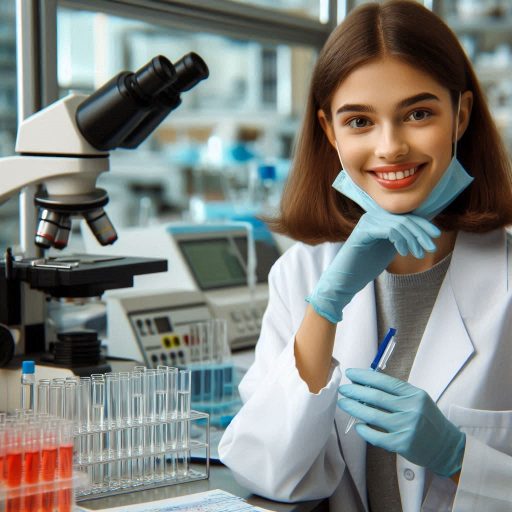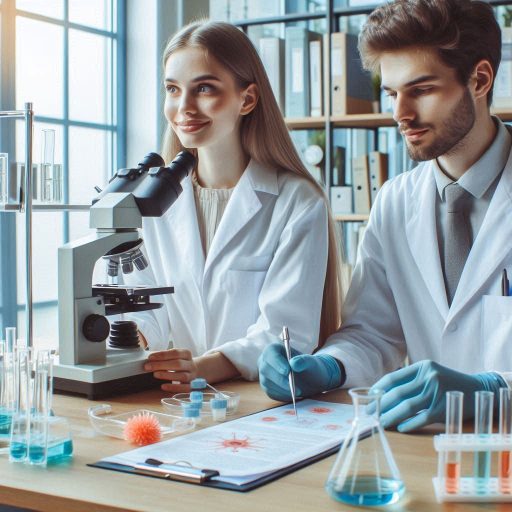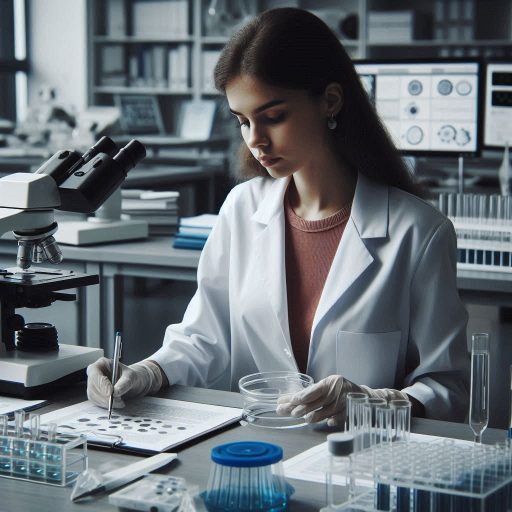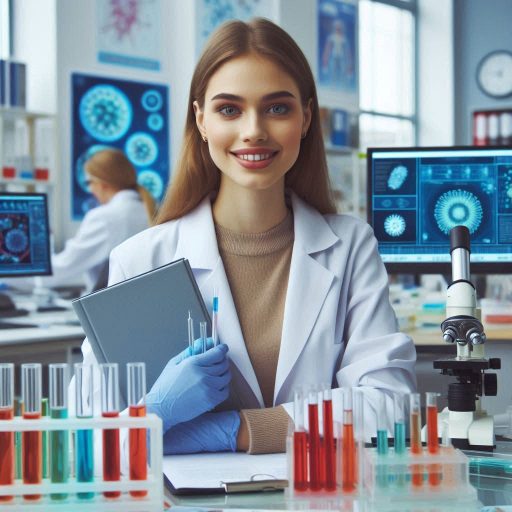Introduction
Lab equipment is essential for microbiologists, as it directly impacts the accuracy, efficiency, and safety of their research and experimentation.
In microbiology, where precision is crucial, the right equipment ensures that procedures are carried out effectively and results are reliable.
This is particularly important in areas like disease research, environmental analysis, and biotechnology, where even the smallest errors can lead to significant setbacks.
The right tools enable microbiologists to work efficiently.
These tools streamline sample collection, analysis, and experimentation.
For example, advanced microscopes allow for the detailed observation of microorganisms, helping scientists study their structures and behavior.
Incubators, autoclaves, and centrifuges play critical roles in growing microorganisms, ensuring accurate results.
These tools help isolate and analyze microorganisms effectively, guaranteeing reproducible outcomes.
Furthermore, well-equipped laboratories not only boost productivity but also enhance safety.
Proper tools and sterile conditions help microbiologists avoid contamination and preserve the integrity of their samples.
Contamination can compromise entire experiments, leading to inaccurate conclusions, wasted resources, and potential health risks.
Microbiologists use specialized equipment like biosafety cabinets and sterilization tools to maintain clean work environments.
They ensure the safety of their studies through rigorous sterilization and contamination control measures.
Microscopes
Microscopes play a vital role in microbiology research, allowing scientists to observe microorganisms that are otherwise invisible.
Microbiologists rely on microscopes to study bacteria, viruses, fungi, and other microscopic organisms at a cellular level.
Without microscopes, understanding these organisms‘ structure and behavior would be nearly impossible.
Importance of Microscopes in Microbiology Research
Microscopes enable microbiologists to identify and analyze microorganisms crucial for medical, environmental, and industrial applications.
By examining the morphology and cellular structure, researchers can detect harmful pathogens, develop antibiotics, and explore new ways to combat diseases.
Microscopes also aid in studying beneficial microorganisms used in biotechnology and agriculture.
This tool is indispensable for advancing our knowledge of microbial processes and their interactions with the environment.
Types of microscopes used in microbiology (light microscope, electron microscope, etc.)
Several types of microscopes are used in microbiology, each serving a specific purpose.
The most common type is the light microscope, which uses visible light to magnify samples.
It‘s widely used for observing stained bacteria, fungi, and protozoa.
Light microscopes are essential for teaching microbiology students and for routine laboratory work, allowing users to examine cells at high magnifications.
The electron microscope offers even greater magnification, allowing researchers to observe microorganisms at the subcellular level.
Two main types of electron microscopes exist: the transmission electron microscope (TEM) and the scanning electron microscope (SEM).
TEMs allow microbiologists to view the internal structure of cells, while SEMs provide detailed images of surface structures.
Electron microscopes are crucial for investigating viruses and molecular details that light microscopes cannot resolve.
Another essential type is the fluorescence microscope, which uses fluorescent dyes and special light sources.
Fluorescence microscopes allow researchers to study specific proteins, DNA, or cell structures with greater precision.
They are particularly useful in diagnosing diseases and conducting genetic research.
Confocal microscopes, a subtype of fluorescence microscopes, offer 3D imaging capabilities, enabling more detailed analysis of microbial communities.
How microscopes help microbiologists study microorganisms at a cellular level
Microscopes allow microbiologists to visualize and analyze microorganisms at a cellular level, revealing their structure, function, and behavior.
They help researchers identify pathogens, monitor microbial growth, and investigate biological processes.
Microscopes are crucial for discovering new antibiotics, studying microbial resistance, and advancing medical research.
Whether using light microscopes for routine analysis or electron microscopes for in-depth cellular exploration, microscopes remain indispensable in microbiology research.
By unlocking the microbial world, microscopes have revolutionized how scientists understand and manipulate microorganisms for various applications.
Read: Profiles in Success: Leading Chemists of the 21st Century in the US
Incubators
Incubators are essential tools in microbiology labs, providing controlled environments for culturing microorganisms.
They help maintain optimal conditions for growth by regulating temperature, humidity, and gas concentrations.
Microbiologists rely on incubators to grow and preserve various types of microorganisms, ensuring reliable and reproducible results.
Role of Incubators in Microbiology Labs
Incubators create stable environments necessary for microorganism cultivation.
They maintain precise temperature settings, allowing for optimal microbial growth.
Incubators are especially critical in experiments that require strict conditions, such as bacterial culture, cell culture, and fermentation processes.
Consistency in temperature and atmospheric conditions helps ensure accurate results and prevents contamination.
Types of incubators available (CO2 incubators, shaking incubators, etc.)
There are several types of incubators used in microbiology labs, each designed for specific purposes:
- CO2 Incubators: CO2 incubators are ideal for cell culture and tissue engineering.
They regulate both temperature and carbon dioxide levels, simulating the human body’s natural environment.
This type of incubator is essential for growing mammalian cells, as it maintains the proper pH balance for cell survival. - Shaking Incubators: Shaking incubators combine temperature control with continuous shaking motion.
This design makes them ideal for growing cultures that need constant agitation.
They are commonly used for bacterial and yeast cultures, ensuring even distribution of nutrients and gases for faster growth. - Refrigerated Incubators: Microbiologists use refrigerated incubators to grow microorganisms at low temperatures.
This is crucial for studying psychrophilic organisms.
These incubators also provide a controlled environment for long-term storage of microbial cultures. - Dry Heat Incubators: Dry heat incubators are used when precise temperature regulation is needed without humidity.
They are ideal for culturing heat-resistant microorganisms or conducting experiments that require dry conditions.
How incubators provide a controlled environment for culturing microorganisms
Incubators are crucial in providing the necessary conditions for microbial growth.
They help microbiologists cultivate a wide variety of organisms, including bacteria, fungi, and viruses.
Incubators control temperature, humidity, and gas levels.
They create optimal conditions for microorganism growth.
This process improves experiment accuracy and reduces contamination risk.
Incubators are also invaluable for preserving microbial cultures over extended periods.
Some incubators can maintain temperatures suitable for cryopreservation, keeping microbial strains viable for future research.
Incubators play a vital role in microbiology labs by providing controlled environments for culturing microorganisms.
With various types available, including CO2 and shaking incubators, microbiologists can ensure accurate results and efficient microbial growth.
Read: The Life and Times of a U.S. Physicist: A Day in Detail
Autoclaves
Autoclaves play a crucial role in microbiology labs.
They ensure the sterilization of equipment and materials.
Understanding their purpose and processes is vital for any microbiologist.
Purpose of autoclaves in microbiology labs
Autoclaves serve multiple functions in microbiology labs:
- Sterilization of Equipment: Autoclaves sterilize glassware, tools, and instruments to eliminate harmful microorganisms.
- Preparation of Media: They sterilize growth media to support the growth of specific microbes.
- Decontamination of Waste: Autoclaves help decontaminate biological waste before disposal.
By effectively sterilizing equipment and media, autoclaves enhance the safety and reliability of microbiological experiments.
Sterilization Process Using Autoclaves
The sterilization process in autoclaves relies on steam under pressure.
Here‘s how it works:
Transform Your Career Today
Unlock a personalized career strategy that drives real results. Get tailored advice and a roadmap designed just for you.
Start Now- Loading the Autoclave: Place items in the autoclave chamber, ensuring proper arrangement for steam circulation.
- Sealing the Chamber: Close the door securely to create an airtight seal.
- Heating the Water: The autoclave heats water to create steam, reaching a temperature of 121‘C (250‘F).
- Building Pressure: The steam increases pressure within the chamber, raising the boiling point of water.
- Sterilization Cycle: Maintain the pressure and temperature for a specific duration, typically 15-30 minutes.
- Cooling Down: After the cycle, allow the autoclave to cool and depressurize before opening.
This process effectively destroys bacteria, viruses, and spores, ensuring complete sterilization.
How autoclaves help prevent contamination in experiments
Autoclaves play a key role in preventing contamination.
Here‘s how they contribute to sterile environments:
- Elimination of Pathogens: By sterilizing all lab equipment, autoclaves remove potential pathogens that can contaminate experiments.
- Consistent Results: Using sterilized media and tools ensures reproducibility and accuracy in microbiological research.
- Protecting Laboratory Personnel: Autoclaving waste and used materials reduces the risk of exposure to infectious agents.
- Enhancing Research Integrity: Sterile conditions lead to reliable experimental outcomes, supporting valid conclusions.
By preventing contamination, autoclaves help maintain the integrity of microbiological research.
Autoclaves are indispensable in microbiology labs.
They ensure the sterilization of equipment, effectively eliminating harmful microorganisms.
By utilizing autoclaves, microbiologists can conduct experiments with confidence, knowing they maintain sterile conditions.
Proper use of autoclaves not only protects researchers but also enhances the quality of scientific work.
Every microbiologist should appreciate the critical role autoclaves play in laboratory safety and research excellence.
Read: Salary Ranges: What to Expect as a Physicist in the USA
Pipettes
Significance of pipettes in microbiology experiments
Pipettes play a crucial role in microbiology experiments.
They enable microbiologists to transfer small volumes of liquids accurately and efficiently.
Precision and accuracy are essential in microbiological research, where even minor discrepancies can affect results.
Various types of pipettes serve different purposes in the lab.
Types of pipettes used (micropipettes, serological pipettes, etc.)
Micropipettes
Are the most commonly used pipettes in microbiology.
They allow researchers to measure and transfer volumes as small as one microliter.
These pipettes typically come in fixed or variable volume designs.
Fixed-volume micropipettes deliver a specific amount of liquid, while variable-volume micropipettes allow users to select the desired volume within a range.
This versatility makes micropipettes ideal for numerous applications, such as DNA sequencing and PCR.
Serological pipettes
Another important type of pipette in microbiology.
They come in larger sizes, typically ranging from 1 to 50 milliliters.
Researchers use serological pipettes to transfer larger volumes of liquid when necessary.
These pipettes often feature graduation marks along the side for easy volume measurement.
The design ensures accurate delivery and allows for effective mixing of samples.
Pipette tips
Play a critical role in maintaining accuracy and precision.
They prevent contamination and ensure that samples remain uncontaminated during transfers.
Pipette tips come in various sizes to accommodate different pipette types.
Proper use of tips minimizes the risk of cross-contamination between samples, which is vital in microbiological studies.
Precision and accuracy offered by pipettes in measuring small volumes of liquids
Using pipettes offers significant advantages in measuring small volumes of liquids.
Their design ensures consistent and reliable results, which is essential in microbiological experiments.
Accurate liquid handling contributes to reproducibility in research, allowing scientists to validate their findings.
Researchers use pipettes for precise measurements in sensitive biological assays and cell cultures.
This precision allows them to conduct experiments that require exact measurements.
To maintain pipette accuracy, regular calibration is necessary.
Labs should implement a routine calibration schedule to ensure pipettes function correctly.
Users should also be trained in proper pipetting techniques to avoid common errors, such as air aspiration or improper tip placement.
Understanding the importance of proper pipetting techniques enhances the reliability of results.
In short, pipettes are indispensable tools for microbiologists.
Their ability to deliver precise and accurate liquid measurements is vital for successful experiments.
Different types of pipettes, such as micropipettes and serological pipettes, cater to various needs in the laboratory.
By ensuring accurate liquid handling, pipettes contribute significantly to the advancement of microbiological research.
Read: Physics Specializations: Choosing Your Path in the U.S.

Safety cabinets
Importance of Safety Cabinets in Microbiology Labs
Safety cabinets play a vital role in microbiology laboratories, providing essential protection for both researchers and the samples they handle.
These cabinets create a controlled environment that minimizes exposure to hazardous materials, such as infectious agents and toxic chemicals.
By using safety cabinets, microbiologists can conduct their work with a greater degree of safety and confidence, knowing they are safeguarded against potential risks.
Types of Safety Cabinets (biological safety cabinets, laminar flow cabinets, etc.)
There are several types of safety cabinets commonly utilized in microbiology labs, each serving a distinct purpose:
Biological Safety Cabinets (BSCs)
Biological Safety Cabinets (BSCs) are specifically designed to protect laboratory personnel, the environment, and samples from exposure to hazardous biological materials.
BSCs operate by using a combination of airflow patterns and HEPA filters to ensure that both the operator and the environment remain uncontaminated.
They come in three classes‘Class I, Class II, and Class III‘each providing different levels of protection based on the nature of the work being performed.
Laminar Flow Cabinets
Laminar flow cabinets offer a sterile working environment by directing a continuous flow of filtered air over the work area.
This airflow prevents contamination from airborne particles, protecting sensitive samples.
These cabinets are ideal for procedures that require a clean environment, such as tissue culture and microbiological testing.
Glove Boxes
Glove boxes are sealed containers equipped with built-in gloves that allow researchers to handle hazardous materials without direct exposure.
They create an isolated environment where sensitive experiments can be conducted safely.
Glove boxes are particularly useful when dealing with highly infectious agents or toxic chemicals that require maximum containment.
How safety cabinets help protect microbiologists from potentially harmful microorganisms
Safety cabinets provide numerous protections for microbiologists, significantly reducing the risks associated with handling hazardous materials:
Containment of Hazardous Materials
One of the primary functions of safety cabinets is to contain hazardous materials within a defined space.
This containment minimizes the risk of exposure to harmful substances, ensuring that both the operator and the surrounding environment remain safe.
Filtered Airflow
BSCs and laminar flow cabinets are equipped with HEPA filters that remove contaminants from the air.
This filtered airflow is crucial in maintaining a sterile working environment, preventing cross-contamination of samples.
Personal Protection
Safety cabinets provide a physical barrier between microbiologists and potentially harmful microorganisms.
This separation is crucial for minimizing the risk of accidental exposure.
Transform Your Career Today
Unlock a personalized career strategy that drives real results. Get tailored advice and a roadmap designed just for you.
Start NowCompliance with Regulations
Using safety cabinets is often a regulatory requirement in microbiology labs.
Complying with safety standards and guidelines helps laboratories maintain accreditation.
It also ensures they operate within health and safety laws.
Safety cabinets are indispensable pieces of equipment in microbiology labs, offering crucial protection for both lab personnel and the samples they handle.
By understanding the different types and functions of safety cabinets, microbiologists can ensure a safe and sterile working environment for their research and experiments.
Investing in high-quality safety cabinets not only protects researchers but also promotes a culture of safety and excellence in scientific inquiry.
As microbiology evolves, safety cabinets become increasingly vital.
This growth emphasizes the need for strict safety protocols in laboratories worldwide.
See Related Content: Top Universities for Soil Science Programs
Centrifuges
Role of centrifuges in microbiology research
Centrifuges play a vital role in microbiology research.
They separate mixtures based on density and particle size, which is crucial for various applications.
By spinning samples at high speeds, centrifuges create centrifugal force that pushes denser particles to the bottom.
This process allows microbiologists to isolate cells, organelles, and other components for further study.
Types of centrifuges available (benchtop centrifuges, ultracentrifuges, etc.)
Microbiologists have several types of centrifuges to choose from, each serving different purposes:
- Benchtop Centrifuges: These compact devices are ideal for routine laboratory use.
They accommodate various tube sizes and can perform multiple spins.
Benchtop centrifuges are commonly used for separating cellular components from culture media. - Ultracentrifuges: Ultracentrifuges operate at significantly higher speeds than standard centrifuges.
They can achieve forces exceeding 100,000 x g, making them suitable for separating very small particles like viruses and macromolecules.
These devices are essential in research involving protein purification and viral studies. - Refrigerated Centrifuges: Refrigerated centrifuges maintain low temperatures during operation.
They are crucial for experiments involving heat-sensitive samples, such as enzymes and cell cultures.
Keeping samples cool prevents degradation and maintains their integrity. - Clinical Centrifuges: These centrifuges are specifically designed for medical applications.
They often include rotor systems tailored for blood and urine samples.
Clinical centrifuges help separate plasma or serum from whole blood efficiently. - Swinging-Bucket Centrifuges: These centrifuges have rotors that swing outward during spinning.
This design allows for a larger capacity and better separation of different components.
They are ideal for separating larger volumes of samples. - Fixed-Angle Centrifuges: Fixed-angle centrifuges hold tubes at a specific angle during spinning.
This design facilitates faster sedimentation and is suitable for pelleting cells.
These centrifuges are often used in routine laboratory procedures.
How centrifuges help separate substances based on density and particle size
Centrifuges separate substances based on their density and size through centrifugal force.
As the rotor spins, particles within the sample experience a force proportional to their mass and the speed of rotation.
Denser particles move outward and settle at the bottom, forming a pellet.
Less dense materials remain suspended in the liquid above, known as the supernatant.
The separation process can be adjusted by changing the speed and duration of the centrifugation.
This flexibility allows microbiologists to optimize protocols for different samples and applications.
Centrifuges are indispensable in microbiology research.
They enable the effective separation of various biological components, aiding in diverse applications.
Understanding the types of centrifuges and their functions helps microbiologists select the right equipment for their specific needs.
By mastering centrifuge techniques, researchers can advance their studies and uncover valuable insights into microbial life.
See Related Content: Top Universities for Seismology Studies in the USA
Gain More Insights: Latest Trends in Immunology Research
Incubator shakers
Incubator shakers play a crucial role in microbiology laboratories.
They provide both incubation and agitation functions, which are vital for growing microorganisms.
Understanding their purpose and features helps microbiologists achieve optimal growth conditions.
Purpose of incubator shakers in microbiology labs
Incubator shakers serve several important functions in microbiology labs:
- Temperature Control: They maintain a stable temperature for optimal microbial growth.
- Agitation: The shaking motion increases oxygen transfer, enhancing growth rates.
- Uniformity: Shaking ensures even distribution of cells and nutrients in the culture medium.
- Versatility: Incubator shakers accommodate various flask sizes and types, from small to large.
How incubator shakers provide both incubation and agitation functions
Incubator shakers combine two essential processes in one unit: incubation and agitation.
Incubation
- The incubator component maintains a controlled temperature environment.
- Microorganisms thrive at specific temperatures, depending on their species.
- Consistent temperature prevents fluctuations that could harm microbial growth.
Agitation
- The shaking function prevents sedimentation of cells.
- Agitation increases nutrient and oxygen availability, promoting faster growth.
- This function mimics natural conditions, where microorganisms experience constant movement.
Importance of maintaining optimal growth conditions for microorganisms
Maintaining optimal growth conditions is crucial for microbiological experiments.
Incubator shakers facilitate these conditions in several ways:
- Consistent Environment: They provide a stable temperature, reducing the risk of contamination and ensuring reproducibility.
- Enhanced Growth Rates: By promoting better oxygenation and nutrient distribution, incubator shakers accelerate microbial growth.
- Improved Experimental Accuracy: Consistent conditions lead to more reliable results in experiments, especially in sensitive studies.
Incubator shakers are essential tools in microbiology laboratories.
Their ability to provide both incubation and agitation makes them invaluable for cultivating microorganisms.
By maintaining optimal growth conditions, they support accurate and reproducible research outcomes.
Investing in high-quality incubator shakers can significantly enhance laboratory efficiency and productivity.
Microbiologists should prioritize these devices to achieve their experimental goals.
Delve into the Subject: Advanced Degrees in Hydrology: Is a PhD Necessary?
Conclusion
Essential lab equipment for microbiologists includes microscopes, autoclaves, incubators, petri dishes, and centrifuges.
Each piece plays a crucial role in microbiological research and experimentation.
Microscopes allow scientists to observe microorganisms in detail, revealing their structure and behavior.
High-quality microscopes enable precise measurements and enhance the accuracy of observations.
Autoclaves are vital for sterilization, ensuring that all tools and media remain uncontaminated.
This sterilization process is critical for obtaining reliable results.
Incubators provide optimal growth conditions for cultures, maintaining the ideal temperature and humidity levels necessary for microbial development.
This control over the environment leads to consistent and reproducible outcomes in experiments.
Centrifuges are essential for separating components in a sample, facilitating various microbiological analyses.
By investing in high-quality lab equipment, researchers can significantly improve their efficiency and accuracy.
Quality tools support reliable data collection and analysis, making them indispensable in microbiology.
When microbiologists prioritize their equipment, they increase their chances of successful experiments and valuable findings.
Upgrading or investing in the right lab tools enhances productivity and fosters innovation in the field.
Don’t underestimate the impact of well-chosen lab equipment on your research efforts.




